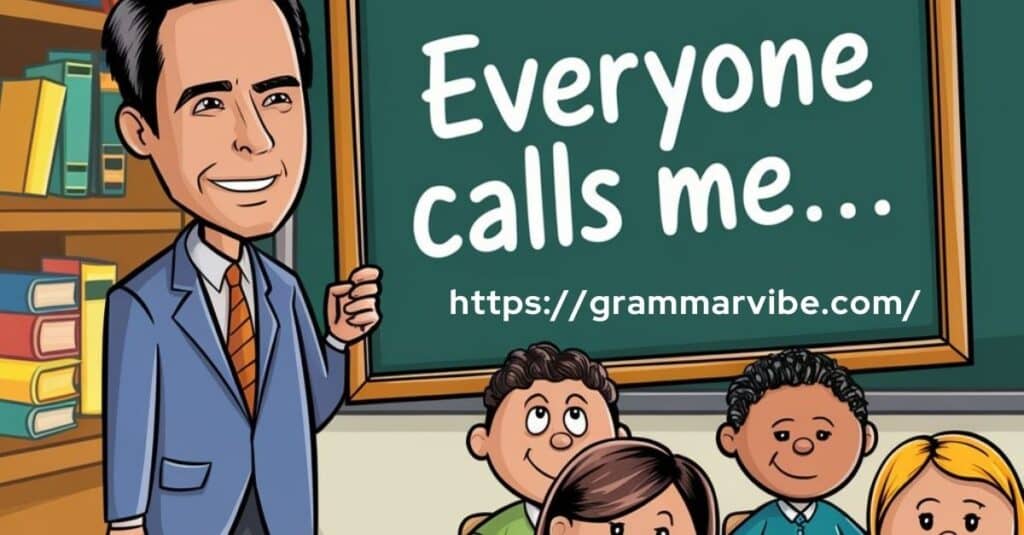Introducing yourself is often one of the first things you do when meeting someone new, but simply saying, “My name is” can feel a bit routine after a while. Whether you’re networking in a professional setting, introducing yourself in an email, or meeting someone in a casual environment, there are various ways to say “My name is” that can set the right tone and make your introduction stand out.
We’ll explore creative and alternative ways to introduce yourself, with scenario examples to help you understand when each one is best suited. By choosing the right self-introduction phrase, you can create a positive first impression and give others insight into your personality, style, and level of formality.
1. I’m Called
Saying “I’m called” is a friendly, straightforward way to introduce yourself. This phrase is casual and approachable, making it perfect for informal settings or social gatherings. You might use this expression when you want to keep things relaxed.
Example:
“Hi! I’m called Jessica, and I’m excited to be joining this project. Let’s make it a success!”
In this example, “I’m called” keeps the tone friendly and open, giving a hint that you’re approachable and ready to engage. This self-introduction works well in social or casual settings where formality isn’t necessary.
2. I Go By
This phrase is suitable for casual introductions and even professional environments where a shorter name might be preferred.
Example:
“Hi, I go by Jake, but my full name is Jacob. Great to meet you all!”
“I go by” sets a friendly, positive first impression and makes it clear how you would like to be addressed without sounding overly formal.
More for you: Synonyms for “Play an Important Role”
3. The Name’s
Using “The name’s” is a confident, impactful way to introduce yourself. This phrase gives a slight dramatic edge to your introduction and is suitable for situations where you want to exude confidence and presence. It’s a popular choice for more formal events or networking sessions where you want to make an impression.
Example:
“Good afternoon, everyone. The name’s William Brown, and I’m here to talk about our project milestones.”
With this phrase, you communicate confidence, making it ideal for professional settings where you want your self-introduction to stand out.
4. You Can Call Me
This phrase is a wonderful choice for both professional and informal settings. “You can call me” is friendly and slightly flexible, making it suitable for most situations where you want to establish a connection without sounding too casual or too formal.
Example:
“Hi! You can call me Olivia. I’ll be handling the marketing for this campaign, so feel free to reach out anytime.”
By choosing this phrase, you offer an inviting first impression and keep your introduction approachable and open.
5. Everyone Calls Me

This phrase is ideal in social settings where a relaxed tone is more suitable.
Example:
“Hey there! Everyone calls me Matt, though my full name is Matthew.”
This is a great casual introduction that helps make a positive impression and puts others at ease, especially in informal environments.
You might also like: Leader’s or Leaders’ or Leaders
6. I Respond To
For a unique, slightly quirky twist, try “I respond to” in your self-introduction. It can work in both professional and casual settings.
Example:
“Hello, I respond to Mr. Lee or simply Tom, whichever you prefer.”
This phrase is a creative language expression that adds a bit of personality and helps others remember your name.
7. My Friends Call Me
Saying “My friends call me” is a casual way to introduce yourself that immediately makes your introduction feel friendly and approachable. It works well in social situations where you’re meeting new people and want to establish a friendly vibe.
Example:
“Nice to meet you! My friends call me Rachel, but you might see me on emails as Rachael Brown.”
This approach allows for a relaxed introduction, perfect for informal settings where a casual introduction is more appropriate.
8. People Know Me As
“People know me as” is a flexible phrase that you can use in both professional and casual introductions. This phrase works especially well if you use a different name professionally or have a nickname that people are familiar with.
Example:
“People know me as E. M. Cross in my writing circles, but you can call me Evelyn.”
With this self-introduction, you offer a bit of insight into your public identity and make a memorable first impression.
Check out this: Other Ways to Say “Firstly, Secondly, Thirdly”
9. I Prefer to Be Called
It’s especially useful in both personal and professional settings where you want to clearly state how you’d like to be addressed.
Example:
“Hello, I prefer to be called Dr. Moore, but feel free to use just Alex if that’s easier.”
This phrase is perfect for conveying a polished introduction that respects your personal preference.
10. They Call Me
For a playful, informal introduction, “They call me” is ideal. It’s suitable for social gatherings or friendly events where a casual introduction will make people feel more at ease.
Example:
“Hey! They call me Danny, though my full name is Daniel.”
This phrase is lighthearted, adding a relaxed vibe to your self-introduction and inviting others to feel comfortable around you.
11. Known by Many as
“Known by many as” is an introduction phrase that exudes a sense of impact or accomplishment.
Example:
“Known by many as The Finance Mentor, but you can call me Nina.”
This phrase highlights your public identity and can be useful in both formal and informal professional settings.
For your interest: Other Ways to Say “Please Disregard My Previous Email”
12. Let Me Introduce Myself As
If you’re introducing yourself in a formal environment, “Let me introduce myself as” is a polished and straightforward choice. It’s suitable for business meetings, conferences, and any other professional setting.
Example:
“Let me introduce myself as James Carter, the head of operations here.”
This phrase works well for establishing a clear, refined introduction without being overly casual.
13. You May Address Me As

For formal or official situations, “You may address me as” provides a professional, respectful tone.
Example:
“Good afternoon. You may address me as Professor Black, and I’ll be leading today’s seminar.”
This formal introduction is ideal when you’re aiming to create a serious or official impression.
14. In Case You’re Wondering, It’s
In social gatherings or casual meetings, “In case you’re wondering, it’s” is a friendly way to introduce yourself. It’s a bit more informal and helps you sound approachable and easygoing.
Example:
“Hi there! In case you’re wondering, it’s Ben. Nice to meet you all!”
This phrase is great for informal introductions where you want to come across as friendly and personable.
15. I’m Formally Known As
When you want to introduce yourself in a way that highlights your professional name or title, “I’m formally known as” is a great option. It’s suitable for professional events and situations where formality is expected.
Example:
“I’m formally known as Dr. Roberts, but feel free to call me Anna if that’s more comfortable.”
This polished introduction is perfect for maintaining professionalism while offering a bit of personal flexibility.
Table of alternative ways to say “My Name Is”:
| Alternative Phrase | Example |
|---|---|
| I’m Called | “Hi! I’m called Jessica, and I’m excited to be joining this project. Let’s make it a success!” |
| I Go By | “Hi, I go by Jake, but my full name is Jacob. Great to meet you all!” |
| The Name’s | “Good afternoon, everyone. The name’s William Brown, and I’m here to talk about our project milestones.” |
| You Can Call Me | “Hi! You can call me Olivia. I’ll be handling the marketing for this campaign, so feel free to reach out anytime.” |
| Everyone Calls Me | “Hey there! Everyone calls me Matt, though my full name is Matthew.” |
| I Respond To | “Hello, I respond to Mr. Lee or simply Tom, whichever you prefer.” |
| My Friends Call Me | “Nice to meet you! My friends call me Rachel, but you might see me on emails as Rachael Brown.” |
| People Know Me As | “People know me as E. M. Cross in my writing circles, but you can call me Evelyn.” |
| I Prefer to Be Called | “Hello, I prefer to be called Dr. Moore, but feel free to use just Alex if that’s easier.” |
| They Call Me | “Hey! They call me Danny, though my full name is Daniel.” |
| Known by Many as | “Known by many as The Finance Mentor, but you can call me Nina.” |
| Let Me Introduce Myself As | “Let me introduce myself as James Carter, the head of operations here.” |
| You May Address Me As | “Good afternoon. You may address me as Professor Black, and I’ll be leading today’s seminar.” |
| In Case You’re Wondering, It’s | “Hi there! In case you’re wondering, it’s Ben. Nice to meet you all!” |
| I’m Formally Known As | “I’m formally known as Dr. Roberts, but feel free to call me Anna if that’s more comfortable.” |
Conclusion
Exploring different ways to say “my name is” offers a unique opportunity to express personality and adapt to various settings. Each alternative phrase allows you to set a tone—whether formal, casual, playful, or polished—that aligns with the environment and helps create a memorable first impression.
Ultimately, having a variety of self-introduction options at your disposal allows you to be versatile, leaving a lasting impression and opening up conversations with ease. Selecting the right phrase is more than just a language expression; it’s an opportunity to present yourself with authenticity and confidence. Embracing these alternatives can enhance your personal interactions and leave others with a positive first impression.

Kyren Paul is an experienced blogger and the creative mind behind “Grammar Vibe.” With a passion for the nuances of English grammar, he brings clarity and insight to everyday language topics, making grammar accessible and engaging for readers of all levels.











Leave a Comment